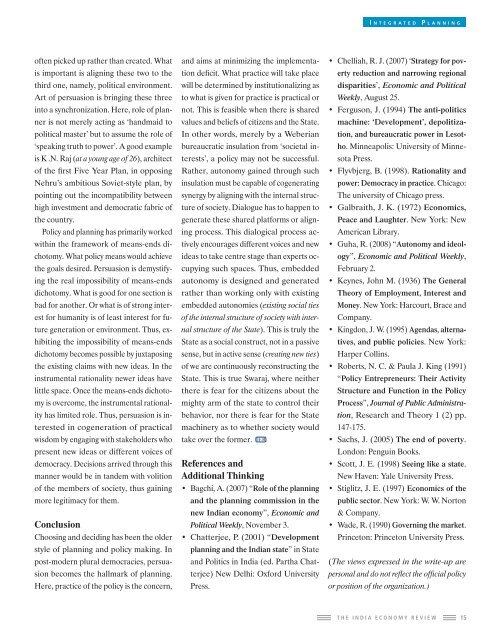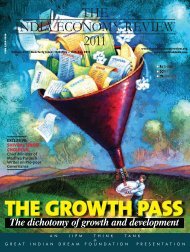Download - The India Economy Review
Download - The India Economy Review
Download - The India Economy Review
Create successful ePaper yourself
Turn your PDF publications into a flip-book with our unique Google optimized e-Paper software.
often picked up rather than created. What<br />
is important is aligning these two to the<br />
third one, namely, political environment.<br />
Art of persuasion is bringing these three<br />
into a synchronization. Here, role of plan-<br />
ner is not merely acting as ‘handmaid to<br />
political master’ but to assume the role of<br />
‘speaking truth to power’. A good example<br />
is K .N. Raj (at a young age of 26), architect<br />
of the fi rst Five Year Plan, in opposing<br />
Nehru’s ambitious Soviet-style plan, by<br />
pointing out the incompatibility between<br />
high investment and democratic fabric of<br />
the country.<br />
Policy and planning has primarily worked<br />
within the framework of means-ends dichotomy.<br />
What policy means would achieve<br />
the goals desired. Persuasion is demystifying<br />
the real impossibility of means-ends<br />
dichotomy. What is good for one section is<br />
bad for another. Or what is of strong interest<br />
for humanity is of least interest for future<br />
generation or environment. Thus, exhibiting<br />
the impossibility of means-ends<br />
dichotomy becomes possible by juxtaposing<br />
the existing claims with new ideas. In the<br />
instrumental rationality newer ideas have<br />
little space. Once the means-ends dichotomy<br />
is overcome, the instrumental rationality<br />
has limited role. Thus, persuasion is interested<br />
in cogeneration of practical<br />
wisdom by engaging with stakeholders who<br />
present new ideas or different voices of<br />
democracy. Decisions arrived through this<br />
manner would be in tandem with volition<br />
of the members of society, thus gaining<br />
more legitimacy for them.<br />
Conclusion<br />
Choosing and deciding has been the older<br />
style of planning and policy making. In<br />
post-modern plural democracies, persuasion<br />
becomes the hallmark of planning.<br />
Here, practice of the policy is the concern,<br />
and aims at minimizing the implementation<br />
defi cit. What practice will take place<br />
will be determined by institutionalizing as<br />
to what is given for practice is practical or<br />
not. This is feasible when there is shared<br />
values and beliefs of citizens and the State.<br />
In other words, merely by a Weberian<br />
bureaucratic insulation from ‘societal interests’,<br />
a policy may not be successful.<br />
Rather, autonomy gained through such<br />
insulation must be capable of cogenerating<br />
synergy by aligning with the internal structure<br />
of society. Dialogue has to happen to<br />
generate these shared platforms or aligning<br />
process. This dialogical process actively<br />
encourages different voices and new<br />
ideas to take centre stage than experts occupying<br />
such spaces. Thus, embedded<br />
autonomy is designed and generated<br />
rather than working only with existing<br />
embedded autonomies (existing social ties<br />
of the internal structure of society with internal<br />
structure of the State). This is truly the<br />
State as a social construct, not in a passive<br />
sense, but in active sense (creating new ties)<br />
of we are continuously reconstructing the<br />
State. This is true Swaraj, where neither<br />
there is fear for the citizens about the<br />
mighty arm of the state to control their<br />
behavior, nor there is fear for the State<br />
machinery as to whether society would<br />
take over the former.<br />
References and<br />
Additional Thinking<br />
Bagchi, A. (2007) “ Role of the planning<br />
and the planning commission in the<br />
new <strong>India</strong>n economy”, Economic and<br />
Political Weekly, November 3.<br />
Chatterjee, P. (2001) “ Development<br />
planning and the <strong>India</strong>n state” in State<br />
and Politics in <strong>India</strong> (ed. Partha Chatterjee)<br />
New Delhi: Oxford University<br />
Press.<br />
I NTEGRATED PLANNING<br />
Chelliah, R. J. (2007) ‘ Strategy for poverty<br />
reduction and narrowing regional<br />
disparities’, Economic and Political<br />
Weekly, August 25.<br />
Ferguson, J. (1994) <strong>The</strong> anti-politics<br />
machine: ‘Development’, depolitization,<br />
and bureaucratic power in Lesotho.<br />
Minneapolis: University of Minnesota<br />
Press.<br />
Flyvbjerg, B. (1998). Rationality and<br />
power: Democracy in practice. Chicago:<br />
<strong>The</strong> university of Chicago press.<br />
Galbraith, J. K. (1972) Economics,<br />
Peace and Laughter. New York: New<br />
American Library.<br />
Guha, R. (2008) “ Autonomy and ideology”,<br />
Economic and Political Weekly,<br />
February 2.<br />
Keynes, John M. (1936) <strong>The</strong> General<br />
<strong>The</strong>ory of Employment, Interest and<br />
Money. New York: Harcourt, Brace and<br />
Company.<br />
Kingdon, J. W. (1995) Agendas, alternatives,<br />
and public policies. New York:<br />
Harper Collins.<br />
Roberts, N. C. & Paula J. King (1991)<br />
“Policy Entrepreneurs: <strong>The</strong>ir Activity<br />
Structure and Function in the Policy<br />
Process”, Journal of Public Administration,<br />
Research and <strong>The</strong>ory 1 (2) pp.<br />
147-175.<br />
Sachs, J. (2005) <strong>The</strong> end of poverty.<br />
London: Penguin Books.<br />
Scott, J. E. (1998) Seeing like a state.<br />
New Haven: Yale University Press.<br />
Stiglitz, J. E. (1997) Economics of the<br />
public sector. New York: W. W. Norton<br />
& Company.<br />
Wade, R. (1990) Governing the market.<br />
Princeton: Princeton University Press.<br />
(<strong>The</strong> views expressed in the write-up are<br />
personal and do not reflect the offi cial policy<br />
or position of the organization.)<br />
THE INDIA ECONOMY REVIEW<br />
15





